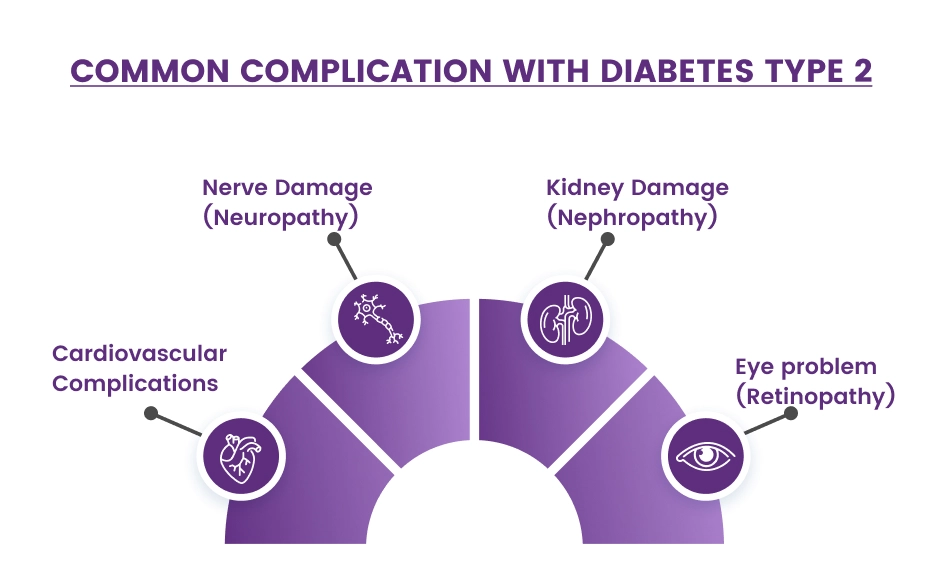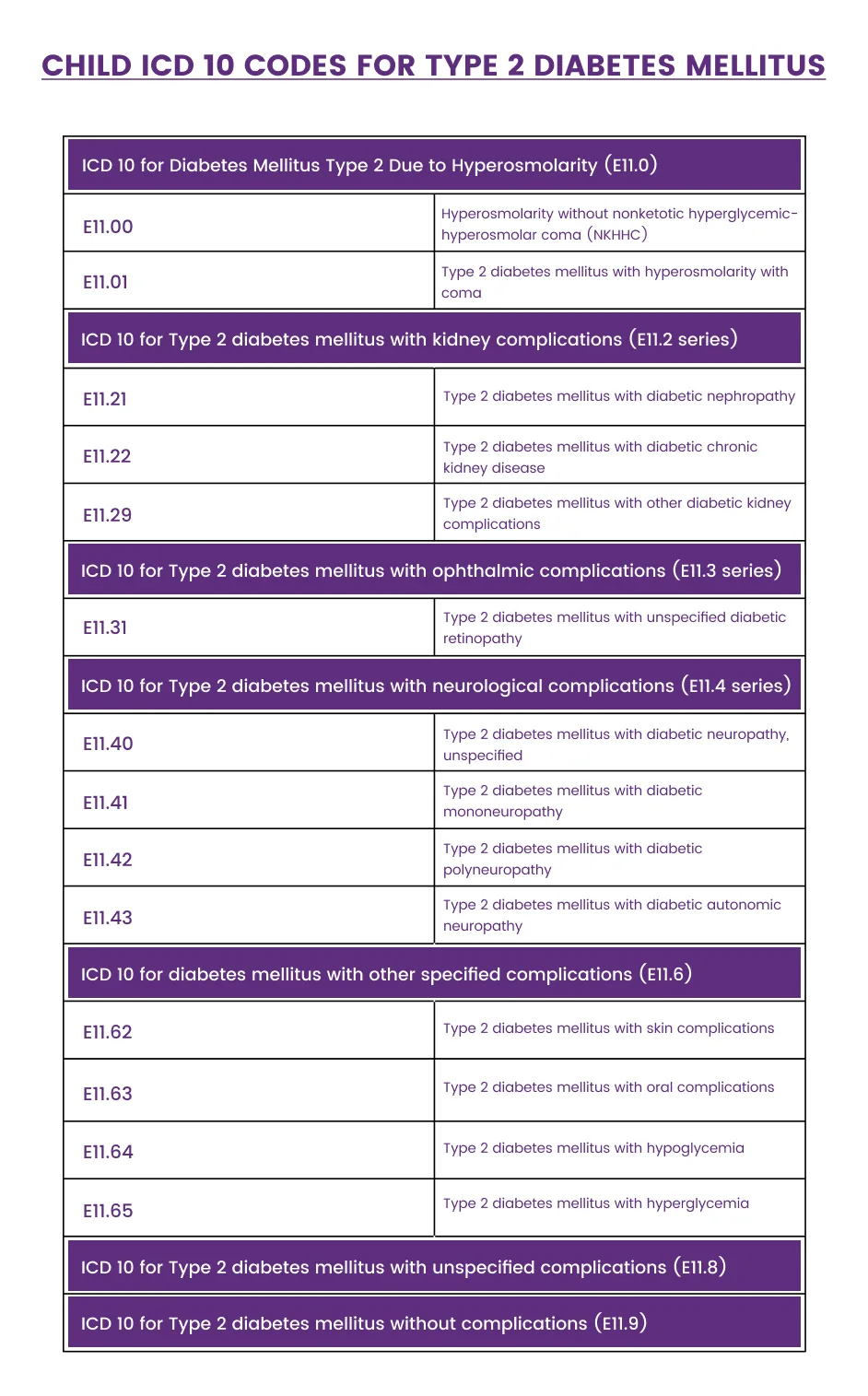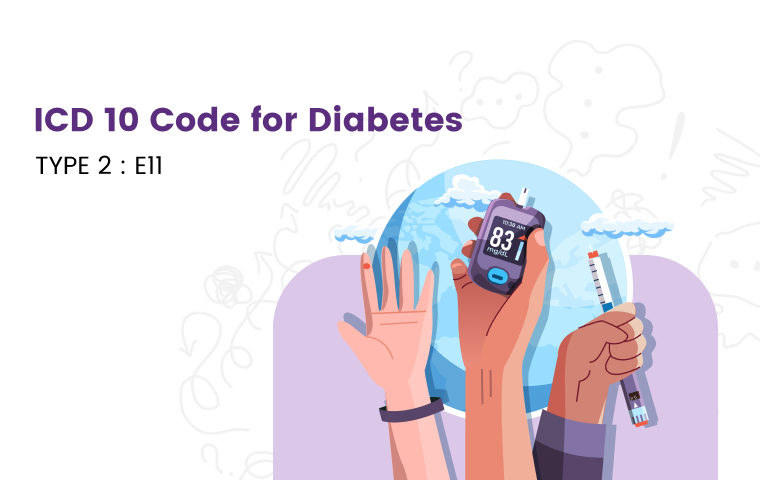In the ever-evolving landscape of modern healthcare, precision and accuracy are paramount to providing exemplary patient care. As dedicated professionals committed to delivering the highest standards of medical practice, you know that every detail counts.
Today, we embark on a journey through the challenging world of ICD-10 codes for different types of diabetes, with a particular focus on type 2 diabetes mellitus.
Our goal is to equip you with the essential knowledge and expertise needed to navigate the complexities of diabetes coding with confidence.
So, let's begin this transformative exploration into the realm of diabetes coding, where precise documentation becomes the cornerstone of exceptional patient outcomes.
Table of Content:
What is ICD 10 Code for Diabetes Type 2
Diabetes type 2 with hyperglycemia
Diabetes Type 2 with complication
Insulin-dependent diabetes type 2
Coding Guidelines for Diabetes Type 2
Child ICD 10 Codes for Type 2 Diabetes Mellitus
What is Type 2 Diabetes?
Diabetes type 2, also known as type 2 diabetes mellitus, is a chronic metabolic disorder characterized by high blood sugar levels. It is one of the most common forms of diabetes and occurs when the body either doesn't produce enough insulin or becomes resistant to the insulin it does produce.
Insulin is a hormone that plays a crucial role in regulating blood sugar levels and helps glucose enter the body's cells for energy use.
What is ICD 10 Code for Diabetes Type 2
E11 is used as icd 10 code type 2 diabetes. This code range includes various subcategories and levels of detail to further specify the type of diabetes, any complications, and associated conditions.
For instance, some additional digits and characters can be added to the base code E11 to provide more precise information about the type of diabetes, such as whether it is with or without complications or related to a specific condition or stage.
The type 2 dm ICD 10 code was effective from October 1, 2015. Prior to this date, the 9th Revision (ICD-9) was in use, and type 2 diabetes was coded differently under that system.
Prediabetes
Prediabetes is a condition in which blood sugar levels are higher than normal but not yet high enough to be classified as type 2 diabetes. It is considered an intermediate stage between normal blood sugar levels and diabetes. R73.03 is used as prediabetes ICD 10 code.
Diabetes type 2 with Hyperglycemia
Diabetes type 2 with hyperglycemia refers to a specific presentation of type 2 diabetes mellitus where the individual experiences elevated levels of glucose (sugar) in the bloodstream. Hyperglycemia occurs when the body's cells are unable to effectively utilize insulin to take up glucose from the blood, leading to a buildup of sugar levels.
The icd 10 code used for diabetes type 2 with hyperglycemia is e11.65. The E11.65 diagnosis code is grouped with the diagnostic-related groups (MS-DRG v40.0).
Diabetes Type 2 with Complication
When blood sugar levels are consistently high, it can lead to damage to various organs and systems in the body, resulting in complications. The Diagnosis code e11.8 is known as the icd 10 diabetes type 2 complications.
Some common complications associated with diabetes type 2 include:

- Cardiovascular Complications
- Nerve Damage (Neuropathy)
- Kidney Damage (Nephropathy)
- Eye problem (Retinopathy)
Insulin-dependent Diabetes Type 2
In this type of diabetes, the body becomes resistant to the effects of insulin, and the pancreas may not produce enough insulin to meet the body's needs. Z79.4 is used as the ICD 10 for long-term insulin dependent diabetes type 2.
Coding Guidelines for Diabetes Type 2

- When the type of diabetes is not specified in the medical records, it is classified as "diabetes mellitus," and the code E11.9 is used.
- If the patient uses insulin but the type of diabetes is not mentioned, the same code E11.9 is used. You can also add the code Z79.4 to indicate long-term use of insulin or oral hypoglycemic drugs.
- For pregnant women with pre-existing diabetes, use code O24.011-024.93 along with specific diabetes codes (E08.00-E13.9) if the diabetes complicates the pregnancy.
- If a patient has a malfunctioning insulin pump, use a code from the subcategory T85.6 series to specify the type of pump malfunction, followed by code T38.3X6 series to indicate overdosing of insulin or oral hypoglycemic drugs.
- When someone has diabetes due to another medical condition, we use specific codes from the E08, E09, and E13 categories to describe the type of diabetes. These codes help us understand the cause of diabetes, such as an underlying medical condition or certain drugs.
Child ICD 10 Codes for Type 2 Diabetes Mellitus

|
ICD 10 for Diabetes Mellitus Type 2 Due to Hyperosmolarity (E11.0) |
|
|
E11.00 |
Hyperosmolarity without nonketotic hyperglycemic-hyperosmolar coma (NKHHC) |
|
E11.01 |
Type 2 diabetes mellitus with hyperosmolarity with coma |
|
ICD 10 for Type 2 diabetes mellitus with kidney complications (E11.2 series) |
|
|
E11.21 |
Type 2 diabetes mellitus with diabetic nephropathy |
|
E11.22 |
Type 2 diabetes mellitus with diabetic chronic kidney disease |
|
E11.29 |
Type 2 diabetes mellitus with other diabetic kidney complications |
|
ICD 10 for Type 2 diabetes mellitus with ophthalmic complications (E11.3 series) |
|
|
E11.31 |
Type 2 diabetes mellitus with unspecified diabetic retinopathy |
|
ICD 10 for Type 2 diabetes mellitus with neurological complications (E11.4 series) |
|
|
E11.40 |
Type 2 diabetes mellitus with diabetic neuropathy, unspecified |
|
E11.41 |
Type 2 diabetes mellitus with diabetic mononeuropathy |
|
E11.42 |
Type 2 diabetes mellitus with diabetic polyneuropathy |
|
E11.43 |
Type 2 diabetes mellitus with diabetic autonomic neuropathy |
|
ICD 10 for diabetes mellitus with other specified complications (E11.6) |
|
|
E11.62 |
Type 2 diabetes mellitus with skin complications |
|
E11.63 |
Type 2 diabetes mellitus with oral complications |
|
E11.64 |
Type 2 diabetes mellitus with hypoglycemia |
|
E11.65 |
Type 2 diabetes mellitus with hyperglycemia |
|
ICD 10 for Type 2 diabetes mellitus with unspecified complications (E11.8) |
|
|
ICD 10 for Type 2 diabetes mellitus without complications (E11.9) |
|
Final Words
In conclusion, understanding accurate ICD-10 coding for type 2 diabetes is of utmost importance for healthcare providers dedicated to delivering exceptional patient care. The journey through the realm of diabetes coding has provided essential insights into the various aspects of type 2 diabetes, including its complications and subcategories.
Armed with this knowledge, healthcare professionals can confidently navigate the complexities of coding, ensuring precise documentation that serves as the cornerstone of exceptional patient outcomes.
ABOUT AUTHOR

Joe Black
As a blog writer with years of experience in the healthcare industry, I have got what it takes to write well researched content that adds value for the audience. I am a curious individual by nature, driven by passion and I translate that into my writings. I aspire to be among the leading content writers in the world.
